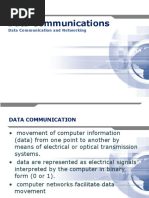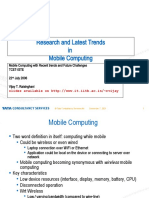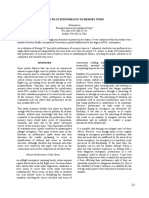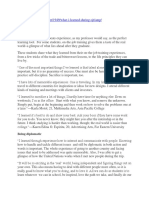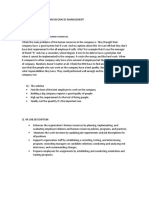Basic Electronics Syllabus
Basic Electronics Syllabus
Uploaded by
Hiren J VasavaCopyright:
Available Formats
Basic Electronics Syllabus
Basic Electronics Syllabus
Uploaded by
Hiren J VasavaOriginal Description:
Copyright
Available Formats
Share this document
Did you find this document useful?
Is this content inappropriate?
Copyright:
Available Formats
Basic Electronics Syllabus
Basic Electronics Syllabus
Uploaded by
Hiren J VasavaCopyright:
Available Formats
Course Title : Basic Electronics
Course code :
GUJARAT TECHNOLOGICAL UNIVERSITY, AHMEDABAD, GUJARAT COURSE CURRICULUM Course Title: Basic Electronics (Code: ) Semester: 2 Degree Programs in which this course is offered Bio-Medical, Bio-technology, Instrumentation & Control, Computer, Information Technology, Computer Science & Engineering, Information & Communication Technology, Electrical & Electronics, Electronics, Electronics & Communication, Electronics & Telecommunication, Electrical, Power Electronics. 1. RATIONALE Pre-requisite Course None Type of Course Basic
Measurement, control and communication functions in all engineering activities and systems are performed by electronics. 2. TEACHING AND EXAMINATION SCHEME Teaching Scheme (In Hours) L 4 T 0 P 2 Total Credits (L+T+P) C 6 Examination Scheme Theory Marks Practical Marks ESE 70 PA 30* ESE Practical 30 PA 150 20 C - Credit; Total Marks
Legends: L - Lecture; T - Tutorial/Teacher Guided Student Activity; P - Practical; ESE - End Semester Examination; PA - Progressive Assessment 3. LEARNING OUTCOMES
LO1
Determine the behaviour of simple passive electrical circuits with independent voltage and current sources.
LO2 LO3 LO4
Design simple analog signal processing functions using operational amplifiers. Design simple combinational and sequential functions using gates and flip-flops. Explain the functioning of digital system components including DACs, ADCs, memory and display devices,
LO5 LO6 LO7
Explain the organization of computer systems and computer networks. Determine the properties of simple signal processing systems. Determine the behavior of analog and digital communication systems.
Course Title : Basic Electronics
Course code :
LO8
Determine the behaviour of simple linear feedback control systems
4.
COURSE DETAILS Sr. No. Unit - 1 Topics Circuit Concepts Electrical Quantities Lumped Circuit Elements Kirchhoffs Laws Meters and Measurements Analogy between Electrical and other Non-Electrical Physical Systems A case study Circuit Analysis Techniques Thevenin and Norton Equivalent Circuits Node-Voltage and Mesh-Current Analysis Superposition and Linearity Wye-Delta Transformation Computer Aided Circuit Analysis A Case Study Analog Building Blocks and Operational Amplifiers The Amplifier Block Ideal Operational Amplifier Practical Properties of Operational Amplifiers Applications of Operational Amplifiers A case study Digital Building Blocks Digital System Building Blocks Digital System Components Computer Systems Computer Networks A case study Teaching Hours 6 Text book Chap/Sec Chapter 1 Module Weightage 12
Topics and Subtopics
Unit - 2
Chapter 2
12
Topics and Subtopics
Unit - 3
Chapter 5
16
Topics and Subtopics
Unit - 4 Topics and Subtopics
Chapter 6
16
Course Title : Basic Electronics
Course code :
Unit -5 Topics and Subtopics Unit 6 Topics and Subtopics Unit - 7 Topics and Subtopics 5.
Signal Processing Signals and Spectral Analysis Modulation, Sampling and Multiplexing Interference and Noise A case Study Communication Systems Waves, Transmission Lines, waveguides and Antenna Fundamentals Analog Communication Systems Digital Communication Systems A Case Study Basic Control Systems Feedback Control Systems Digital Control Systems A Case Study
Chapter 14
16
Chapter 15
14
Chapter 16 16.2 to 16.5
14
LIST OF TEXT BOOKS : Author M.S. Sarma Publication Oxford University Press
S. Title of Books No. 1 Introduction to Electrical Engineering 6.
LIST OF EXERCISES/PRACTICAL
The practical/exercises should be properly designed and implemented with an attempt to develop different types of skills so that students are able to acquire the competency. Following is the list of experiments for guidance. A student should perform at least 10 experiments out of the given 14 with at least one experiment from each Unit S. No. Unit No. I Practical/Exercise Apprx. Hrs. Required 2
a. Observe the behaviour of RLC circuits with ideal and non-ideal voltage sources and current sources. b. Verify Thevenins and Nortons Theorems Simulate passive electrical circuits using Multisim simulator and compare the simulated response with that of the actual circuit Determine the parameters of three commercial Op Amps Perform simple analog signal processing functions using Op Amps Design simple combinational
3
II
3 4 5
III III IV
2 2 2
functions
as
per
Course Title : Basic Electronics
Course code :
S. No.
Unit No.
Practical/Exercise
Apprx. Hrs. Required 2 2 2 2 2 2
specifications and verify the correctness of your design 6 7 8 9 10 11 IV IV V V V VI Design simple sequential functions as per specifications and verify the correctness of your design Measure the chatacteristics of given DACs and ADCs Simulate simple modulation, sampling, multiplexing, demodulation signal processing functions Multisim Simulate simple filtering signal processing function Multisim Measure the performance of a given signal processing system Determine the behavior of a given analog communication system through simulation using Multisim Determine the behavior of a given digital communication system through simulation using Multisim Determine the behavior of a second and third order control systems through simulation using Multisim Determine the behavior of a practical control system using ON-OFF and P controllers through simulation using SciLab Determine the behavior of a practical control system using PI and PID controllers through simulation using SciLab 7. LIST OF MAJOR EQUIPMENT/ MATERIALS (1) CRO (At least 20MHz) (2) Function Generator (Frequency range up to 20 MHz) need to have sine, square wave output. (3) Dual Power Supply (0-12V/15V DC)/3A (4) Micrometers for measurement of voltage and current with suitable ranges. (5) Multimeter (6) Various Electronics Components including different types of Op Amps and digital ICs. (7) PCs
12
VI
13 14
VII VII
2 2
Course Title : Basic Electronics
Course code :
8.
List of Software/Learning Websites Software: Learning Material: Multisim and SciLab (www.scilab.org) http://nptel.iitm.ac.in/. www.spoken-tutotial.org
*PA (M): 10 marks for Active Learning Assignments, 20 marks for other methods of PA; The faculty may also allocate additional marks out of PA for Practical for Student Activities. ACTIVE LEARNING ASSIGNMENTS: Students will prepare (i) A case study on a present day electronic system of choice. (ii) Power-point slides, which include videos, animations, pictures, graphics for better understanding theory and practical work The faculty will allocate chapters/ parts of chapters to groups of students so that the entire syllabus of Basic Electronics is covered. The power-point slides should be put up on the web-site of the College/ Institute, along with the names of the students of the group, the name of the faculty, Department and College on the first slide. The best three works should be sent to achievements@gtu.edu.in.
You might also like
- 6463 7193Document3 pages6463 7193JersonAlejandroTeránEnríquez0% (2)
- Automatic Meter Reading Systems: PPT Manikant LakshkarDocument26 pagesAutomatic Meter Reading Systems: PPT Manikant Lakshkararnav LakshkarNo ratings yet
- CH (5) - Series DC CircuitsDocument66 pagesCH (5) - Series DC CircuitsHasan DaoudNo ratings yet
- CHAPTER 5-LOOPING STATEMENTS - Dis2019Document24 pagesCHAPTER 5-LOOPING STATEMENTS - Dis2019Caroline DameNo ratings yet
- 12K502 Programmable Logic Controller: Microcontrollers andDocument6 pages12K502 Programmable Logic Controller: Microcontrollers andsivaeeinfoNo ratings yet
- Lecture 1 Networking Fundamentals RevisedDocument34 pagesLecture 1 Networking Fundamentals RevisedLouis RuhashaNo ratings yet
- Robot Drive Systems & End EffectorsDocument71 pagesRobot Drive Systems & End EffectorsbabuNo ratings yet
- Software Quality and AssuranceDocument8 pagesSoftware Quality and AssuranceanbusabaNo ratings yet
- Lecture 3 - Data CommunicationsDocument17 pagesLecture 3 - Data CommunicationsJemimah MacatoNo ratings yet
- Application LayerDocument70 pagesApplication LayerFurqan Ali CheemaNo ratings yet
- Introduction To Data MiningDocument37 pagesIntroduction To Data MiningArushi MittalNo ratings yet
- ITEC 80 - Midterm ExaminationDocument2 pagesITEC 80 - Midterm ExaminationFINDING PEACENo ratings yet
- Introduction To Electric CircuitsDocument36 pagesIntroduction To Electric Circuitsמוחמד טאהאNo ratings yet
- CareerDocument75 pagesCareerpandi1985No ratings yet
- Back Patching CC PresentationDocument15 pagesBack Patching CC PresentationSarmad MehmoodNo ratings yet
- Ict ApplicationsDocument25 pagesIct ApplicationsRafael ReinrikaNo ratings yet
- Network TopologiesDocument22 pagesNetwork TopologiessakshamNo ratings yet
- 02 Robot AnatomyDocument35 pages02 Robot AnatomyTonny ThanhNo ratings yet
- Introduction To Embedded SystemsDocument21 pagesIntroduction To Embedded SystemsKen Lip YamNo ratings yet
- EC312 Object Oriented ProgrammingDocument3 pagesEC312 Object Oriented ProgrammingJazir HameedNo ratings yet
- Uses of Value Chain AnalysisDocument14 pagesUses of Value Chain AnalysisAdnan NawabNo ratings yet
- Nano TechnologyDocument32 pagesNano TechnologyPhani ChintuNo ratings yet
- HashingDocument29 pagesHashingaaryan jainNo ratings yet
- ITB Data and InformationDocument100 pagesITB Data and Informationmanjunath90No ratings yet
- Introduction To JavaDocument42 pagesIntroduction To JavaSoumya VijoyNo ratings yet
- DeadlockDocument40 pagesDeadlockHarsh GuptaNo ratings yet
- Application of Computer in Various Fields 2Document45 pagesApplication of Computer in Various Fields 2non of your BusinessNo ratings yet
- What Is Interaction Design?Document51 pagesWhat Is Interaction Design?Vairavel ChenniyappanNo ratings yet
- PHP Syllabus PDFDocument6 pagesPHP Syllabus PDFAmey GobareNo ratings yet
- Digital Electronics RevisionDocument23 pagesDigital Electronics Revisionapi-3701035100% (2)
- C++ Do While LoopDocument7 pagesC++ Do While LoopLeonilive Dela CruzNo ratings yet
- HCIDocument119 pagesHCIPranav MarlaNo ratings yet
- Transaction Concepts: Service-Oriented ComputingDocument38 pagesTransaction Concepts: Service-Oriented ComputingZaid QureshiNo ratings yet
- Unit 1-Fundamentals of DBMSDocument53 pagesUnit 1-Fundamentals of DBMSJenberu MekurianewNo ratings yet
- Embedded SystemsDocument28 pagesEmbedded SystemsCheril Mehta0% (1)
- Computer VisionDocument25 pagesComputer Visionbt21103092 Peyush JindalNo ratings yet
- Analog and Hybrid ComputersDocument14 pagesAnalog and Hybrid ComputerspoojaNo ratings yet
- Cable Configuration: Instructor, Local Tip-Manila Coe Cisco Networking Academy ProgramDocument23 pagesCable Configuration: Instructor, Local Tip-Manila Coe Cisco Networking Academy ProgramPolicarpio D. Tena IINo ratings yet
- Amazing C++ If, Else & Switch StatementsDocument25 pagesAmazing C++ If, Else & Switch Statementsfakenews1945No ratings yet
- Research and Latest Trends in Mobile ComputingDocument50 pagesResearch and Latest Trends in Mobile ComputingDurgaprasad MadamsettyNo ratings yet
- PPT01 - Introduction To Interface DesignDocument27 pagesPPT01 - Introduction To Interface Designmuhammad imanuddinNo ratings yet
- Software Quality AssuranceDocument39 pagesSoftware Quality AssuranceHaveit12No ratings yet
- Control Systems (ELEN90055) Part 1Document17 pagesControl Systems (ELEN90055) Part 1Hunter VerneNo ratings yet
- Intruders: Tran Song Dat Phuc Department of Computer Science and Engineering Seoultech 2014Document65 pagesIntruders: Tran Song Dat Phuc Department of Computer Science and Engineering Seoultech 2014Pavan Kumar NNo ratings yet
- Characteristics of The Analog ComputersDocument5 pagesCharacteristics of The Analog Computersmanju_csNo ratings yet
- Selection Control Structures: 1. Simple If/else 2. Nested If's 3. Ladderized If/else If/else 4. Switch-CaseDocument10 pagesSelection Control Structures: 1. Simple If/else 2. Nested If's 3. Ladderized If/else If/else 4. Switch-CaseChristian Lester GimenoNo ratings yet
- Introduction To Power Electronics: Robert W. Erickson University of Colorado, Boulder Fall 2015Document38 pagesIntroduction To Power Electronics: Robert W. Erickson University of Colorado, Boulder Fall 2015Engenheiro TeslandoNo ratings yet
- Software Development Life Cycle - An OverviewDocument15 pagesSoftware Development Life Cycle - An OverviewPratap K J100% (2)
- Software Quality Assurance - OutlineDocument37 pagesSoftware Quality Assurance - OutlineJeetendra KumarNo ratings yet
- Industrial RevolutionDocument57 pagesIndustrial RevolutionRizwana MiduryNo ratings yet
- P07 Emotional InteractionDocument44 pagesP07 Emotional InteractionRinaldy NugrahaNo ratings yet
- MATH LET REVIEWerDocument101 pagesMATH LET REVIEWerJaymart Hernandez MojicaNo ratings yet
- HashingDocument34 pagesHashingLavanya JNo ratings yet
- Splicing Optical Fiber CableDocument25 pagesSplicing Optical Fiber CableWaleNo ratings yet
- Electronic Devices & Circuits MT240: Spring 2020: Instructor Samina JamilDocument38 pagesElectronic Devices & Circuits MT240: Spring 2020: Instructor Samina JamilAbu Bakar IrfanNo ratings yet
- Basic ElectronicsDocument3 pagesBasic Electronicsvinay10356No ratings yet
- Basic ELectronics - Material - 14022017 - 081630AMDocument348 pagesBasic ELectronics - Material - 14022017 - 081630AMshivaramreddyNo ratings yet
- EE 209: Electrical/Electronics Lab MM 215: Experimental and Measurements LaboratoryDocument15 pagesEE 209: Electrical/Electronics Lab MM 215: Experimental and Measurements LaboratoryAbhishek KumarNo ratings yet
- Nba C6Document23 pagesNba C6Satya NarayanaNo ratings yet
- Bhagwant University Electrical and Electronics Engg. B.Tech Course Semester IiiDocument41 pagesBhagwant University Electrical and Electronics Engg. B.Tech Course Semester IiiMegala DhasarathanNo ratings yet
- STB47203 - Power Electronics and Drive - SLTDocument6 pagesSTB47203 - Power Electronics and Drive - SLTashkaryNo ratings yet
- ACD-20 Question ListDocument1 pageACD-20 Question ListHiren J VasavaNo ratings yet
- VLSI Syllabus-CEDocument1 pageVLSI Syllabus-CEHiren J VasavaNo ratings yet
- AE - Question BankDocument3 pagesAE - Question BankHiren J VasavaNo ratings yet
- Subject: Analog Circuit Design (2141002) Important Question Bank No. Book & Page NoDocument1 pageSubject: Analog Circuit Design (2141002) Important Question Bank No. Book & Page NoHiren J VasavaNo ratings yet
- MMI IMP Questions - SDocument1 pageMMI IMP Questions - SHiren J VasavaNo ratings yet
- SELF DECLARATION (By Student/students) of Each IDP/UDPDocument1 pageSELF DECLARATION (By Student/students) of Each IDP/UDPHiren J VasavaNo ratings yet
- L Edit TutorialDocument25 pagesL Edit TutorialHiren J VasavaNo ratings yet
- Practical List: Sr. No ExperimentDocument1 pagePractical List: Sr. No ExperimentHiren J VasavaNo ratings yet
- Basic Control System - ECDocument23 pagesBasic Control System - ECHiren J VasavaNo ratings yet
- PE - Question Bank1Document1 pagePE - Question Bank1Hiren J VasavaNo ratings yet
- 11 Englishcore Ncert Hornbill Ch3Document6 pages11 Englishcore Ncert Hornbill Ch3JwalantNo ratings yet
- Tutorial1 Chapter1 AnswerDocument8 pagesTutorial1 Chapter1 AnswerJuan CRNo ratings yet
- Theory of LevellingDocument1 pageTheory of LevellingU Mad BRo100% (2)
- Line Pilot Performance of Memory ItemsDocument7 pagesLine Pilot Performance of Memory ItemsMahmed AdeebNo ratings yet
- RRLDocument6 pagesRRLEugeneNo ratings yet
- Energy Forms and ChangesDocument38 pagesEnergy Forms and ChangesllsinclairNo ratings yet
- LearnEnglish Business Magazine Working in A Remote TeamDocument5 pagesLearnEnglish Business Magazine Working in A Remote TeamAshikha MNo ratings yet
- " Load Forecasting Using Fuzzy Logic ": A Project Seminar OnDocument28 pages" Load Forecasting Using Fuzzy Logic ": A Project Seminar OnSURAJNo ratings yet
- Dae Folder 2018Document40 pagesDae Folder 2018Brian KennedyNo ratings yet
- Domain and Range of A FunctionDocument8 pagesDomain and Range of A Functionkiahjessie67% (3)
- DLL All Subjects 2 q4 w7 d1Document7 pagesDLL All Subjects 2 q4 w7 d1Aq C YoyongNo ratings yet
- Quydo Ihya Iqrazi HUMAN RESOURCES MANAGEMENTDocument5 pagesQuydo Ihya Iqrazi HUMAN RESOURCES MANAGEMENTedoedo91No ratings yet
- Chapter 3 - Vlans: Cisco Networking Academy Program at Tstc-WacoDocument36 pagesChapter 3 - Vlans: Cisco Networking Academy Program at Tstc-WacobosnazmajNo ratings yet
- PR en 13286-02 - Proctor CompactionDocument27 pagesPR en 13286-02 - Proctor CompactionDamouh MohamedNo ratings yet
- Various Types of Surfaces: Made By:-Nilesh Bhojani Guided By: - Prof. B.K. PatelDocument15 pagesVarious Types of Surfaces: Made By:-Nilesh Bhojani Guided By: - Prof. B.K. Patelnilesh bhojaniNo ratings yet
- Geologic Timeline - LPDocument4 pagesGeologic Timeline - LPBrennan McGeeNo ratings yet
- Program en USDocument28 pagesProgram en USRadu Alexandru IonutNo ratings yet
- COMPLANTDocument8 pagesCOMPLANTJack NguyenNo ratings yet
- TPMDocument27 pagesTPMkathir100% (4)
- Mayur IndustrialDocument12 pagesMayur IndustrialBittu KumarNo ratings yet
- ENGLISH 10 2nd Quarter Exam (Set A)Document3 pagesENGLISH 10 2nd Quarter Exam (Set A)Mishelle OngNo ratings yet
- Iceman TestDocument7 pagesIceman Testjbk23No ratings yet
- Cover LetterDocument2 pagesCover LetterThrk TwrNo ratings yet
- Os Course Information SheetDocument2 pagesOs Course Information Sheetph2in3856No ratings yet
- Resum For Sagar SawantDocument3 pagesResum For Sagar SawantRushikesh KapaseNo ratings yet
- Communications Plan PPT TemplateDocument12 pagesCommunications Plan PPT TemplatesamyswamyNo ratings yet
- Sample Business Plan - We Can Do It ConsultingDocument8 pagesSample Business Plan - We Can Do It ConsultingIbrahem Mabrouk100% (1)
- Unit 74 Support Individuals With Specific Communication NeedsDocument10 pagesUnit 74 Support Individuals With Specific Communication NeedsEmma HarrisNo ratings yet
- Need of CommunicationDocument7 pagesNeed of CommunicationJijoyMNo ratings yet








